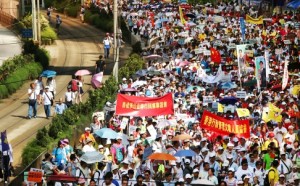A multitude of words have been used to describe the student protestors in Hong Kong, ranging from “patriotic and peaceful” to “gullible“, so which side of the story is closer to the truth? As Canadians, we are generally the audience of foreign media outlets, and it can be hard to decipher differences sent to international media compared to what’s being broadcast by local media. A look at the simple yet drastic effect of news bias in China regarding the Occupy Central movement is both surprising and eye-opening.
China has not only banned Instagram and intensely censored its largest social media platform Weibo since the start of the protests, but have tried to manipulate imagery from the event and match them with questionable headlines or quotations from “authoritative figures”. For example, October 1st was the Chinese National Holiday and an image of Hong Kong demonstrators was used with a headline implying that the crowd was gathered to celebrate the public holiday. It has also in recent days emphasized a reduction in the size of the crowd and a “lack of support” from the international and general Hong Kong public.
Media plays a large role in how audiences form opinions on any issue. Evidently, because Hong Kong is a Special Administrative Region of China, there are drastically different incentives for media outlets based in various countries to portray the Occupy Central news. Personally, I’m lucky to be able to make a quick long distance call to my relatives to find first-hand and non-filtered information; but it seems like nowadays, you just can’t keep biases from blurring facts and reality.
References:
http://time.com/3237227/china-hong-kong-occupy-central-beijing-communist-party/
http://www.vox.com/2014/9/28/6856621/hong-kong-protests-clashes-china-explainer

